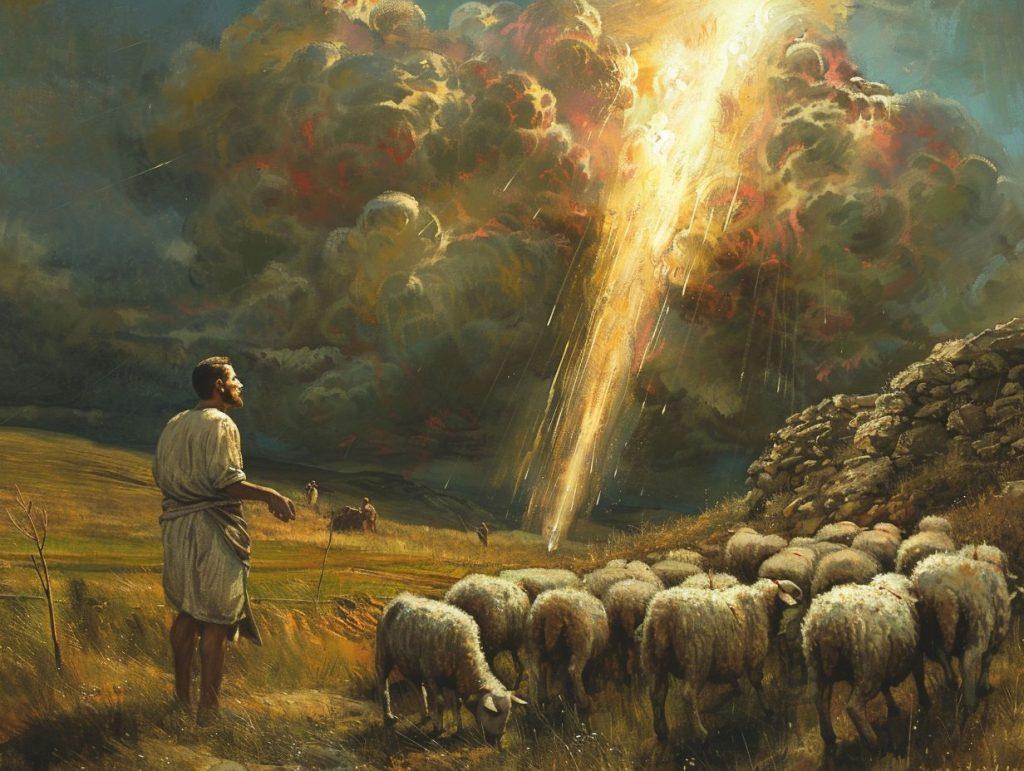Brief Overview
- Abel is a significant figure in the Old Testament, known as the second son of Adam and Eve.
- His story is primarily found in the Book of Genesis, where he is presented as a shepherd who offered a pleasing sacrifice to God.
- Abel’s life was brief, ending in his murder by his brother Cain, making him the first martyr in biblical history.
- Catholic teaching sees Abel as a symbol of righteousness and faith, pointing to the value of offering one’s best to God.
- His death highlights the consequences of sin and envy, themes that remain central to Christian theology.
- This article will explore Abel’s identity, his actions, and his lasting importance in Catholic tradition.
Detailed Response
Abel’s Identity in Scripture
Abel enters the biblical narrative as the younger son of Adam and Eve, born after Cain. His story appears in Genesis 4:1-16, a passage that introduces him briefly but with profound impact. Unlike Cain, who is described as a farmer, Abel is identified as a shepherd, tending flocks. This distinction in their occupations sets the stage for their differing offerings to God. The text does not provide extensive details about Abel’s personality or life, focusing instead on his actions and their consequences. His name, derived from Hebrew, can mean “breath” or “vapor,” suggesting the fleeting nature of his existence. In Catholic tradition, Abel’s brevity of life does not diminish his significance. Rather, it amplifies his role as a figure of innocence and faithfulness. The Church views him as a precursor to Christ, whose own sacrifice would redeem humanity. Abel’s identity, though simple, carries deep symbolic weight in salvation history.
The Offering That Pleased God
Abel’s most defining moment is his offering to God, described in Genesis 4:4. As a shepherd, he brought the firstborn of his flock and their fat portions as a sacrifice. The text notes that God looked with favor on Abel and his offering, though it does not explain why. Catholic theology interprets this favor as a reflection of Abel’s interior disposition—his faith and sincerity. The Catechism of the Catholic Church emphasizes the importance of offering God one’s best (see CCC 2099-2100), a principle Abel exemplifies. In contrast, Cain’s offering from the ground is met with divine displeasure, hinting at a lack of care or devotion. Abel’s sacrifice is not just about the material gift but the heart behind it. Early Church Fathers, like St. Augustine, saw Abel’s offering as a foreshadowing of the Eucharistic sacrifice. This connection ties Abel to the broader story of worship in Catholic teaching. His act remains a timeless example of giving God priority.
The First Murder and Its Meaning
Abel’s life ends tragically when Cain, driven by envy, kills him in Genesis 4:8. This act marks the first recorded murder in scripture, a stark consequence of sin entering the world through Adam and Eve. Cain’s anger stemmed from God’s preference for Abel’s offering, revealing a heart consumed by jealousy. Abel, unaware of his brother’s resentment, becomes a victim of this rage. The text states that Cain lured Abel into a field and struck him down, a premeditated act of violence. Catholic teaching uses this event to illustrate the destructive power of sin (see CCC 2259). Abel’s blood, spilled on the ground, cries out to God, as noted in Genesis 4:10. This cry is seen as a plea for justice, echoing through history. In the Church’s view, Abel’s death underscores the reality of human frailty and the need for redemption. It also establishes him as the first martyr, a title that resonates in Christian martyrdom traditions.
Abel as a Martyr and Symbol of Righteousness
In Catholic tradition, Abel holds the distinction of being the first martyr, a status that elevates his legacy. His death was not a random act but a consequence of his righteousness, as Cain’s envy targeted Abel’s faithfulness. The New Testament reinforces this view in Hebrews 11:4, where Abel is praised for his faith, through which he still speaks despite being dead. This passage suggests that Abel’s witness endures, inspiring believers across generations. The Catechism highlights the value of martyrdom as a testimony to truth (see CCC 2473), a concept rooted in Abel’s story. His blood, crying out to God, prefigures the blood of Christ, shed for humanity’s salvation. Early Christian writers, such as St. Irenaeus, linked Abel’s martyrdom to the persecution of the just. This connection positions Abel as a foundational figure in the theology of suffering. His life, though brief, carries a message of fidelity under trial. Catholic liturgy occasionally references Abel in prayers for martyrs, affirming his enduring role.
The Contrast Between Cain and Abel
The story of Abel cannot be fully understood without considering his brother Cain. Their offerings and fates highlight a stark moral contrast in Genesis 4. Cain’s occupation as a tiller of the soil reflects human toil after the Fall, while Abel’s shepherding evokes a gentler, pastoral image. God’s acceptance of Abel’s sacrifice and rejection of Cain’s sparks the conflict between them. Catholic exegesis sees this as a lesson in intention rather than mere occupation (see CCC 2569). Cain’s response—murder—reveals a heart turned inward, while Abel’s silence suggests trust in God. The Church uses this contrast to teach about the effects of grace and sin. Abel’s righteousness does not provoke pride but instead draws Cain’s wrath. This dynamic illustrates how virtue can incite opposition in a fallen world. The Cain-and-Abel narrative remains a cautionary tale in Catholic moral teaching.
Abel’s Blood and Divine Justice
After Abel’s death, God confronts Cain with the words, “The voice of your brother’s blood is crying to me from the ground” (Genesis 4:10). This powerful image introduces the idea that innocent blood demands justice. In Catholic theology, Abel’s blood is a precursor to the blood of Christ, which speaks a better word than Abel’s, offering mercy (Hebrews 12:24). The Catechism ties this to the dignity of human life and the call for justice (see CCC 2258). Abel’s death was not overlooked by God; it provoked a divine response, cursing Cain to wander. This event underscores God’s attentiveness to the cries of the innocent. The Church sees in Abel’s blood a symbol of all unjust suffering. Early commentators, like St. Ambrose, noted that Abel’s cry prefigures the prayers of the saints. This connection deepens Abel’s role in the theology of intercession. His story reminds Catholics that God hears the voiceless.
Abel in the New Testament
Abel’s significance extends beyond Genesis into the New Testament, where he is explicitly mentioned. In Hebrews 11:4, he is celebrated as a hero of faith, whose sacrifice was accepted because of his righteousness. This text elevates Abel to a model for Christians, emphasizing faith over works alone. Similarly, Matthew 23:35 refers to Abel as “righteous,” linking him to the prophets murdered for their fidelity. Catholic teaching uses these references to frame Abel as a bridge between the Old and New Covenants (see CCC 58). His faith anticipates the fuller revelation of Christ’s sacrifice. The connection is not incidental but intentional, showing God’s consistent favor toward the just. Abel’s inclusion in Hebrews’ “hall of faith” affirms his timeless relevance. The Church encourages believers to see in Abel a call to trust God wholly. His legacy thus spans both Testaments.
Abel and the Theology of Sacrifice
Sacrifice is a central theme in Abel’s story, resonating deeply with Catholic theology. His offering of the firstborn of his flock reflects an understanding of giving God what is most valuable. The Catechism teaches that sacrifice expresses worship and dependence on God (see CCC 2099). Abel’s act aligns with this, distinguishing him from Cain’s lesser effort. Church tradition sees in Abel’s sacrifice a foreshadowing of the Eucharist, where Christ offers Himself fully. This link is not about the material but the disposition of total surrender. Abel’s example challenges Catholics to examine their own offerings—spiritual and material. His story suggests that God values the heart behind the gift. Early liturgical practices drew on Abel’s model to shape Christian worship. Thus, Abel’s sacrifice remains a lens for understanding Eucharistic theology.
Abel’s Place in Salvation History
Abel occupies a unique position in the unfolding of God’s plan for humanity. As the first righteous death in scripture, he marks the beginning of a pattern of sacrifice and redemption. Catholic theology views him as part of the “protoevangelium,” the initial promise of salvation in Genesis 3:15 (see CCC 410). His blood, shed unjustly, points forward to Christ’s atoning death. Abel’s story introduces the cost of fidelity in a sinful world. The Church sees him as a stepping stone in the gradual revelation of God’s mercy. His brief life serves a purpose beyond itself, connecting Adam’s fall to Christ’s victory. Scholars note that Abel’s role is foundational, not incidental. He embodies the tension between sin and grace that defines human history. In this light, Abel is a timeless figure in Catholic salvation narrative.
Abel’s Lasting Legacy in Catholic Tradition
Abel’s influence persists in Catholic thought and practice, despite his short appearance in scripture. His righteousness and martyrdom make him a enduring symbol of faith under persecution. The Church honors him implicitly in its veneration of martyrs and the just. His story is often cited in homilies to illustrate the power of a faithful life. Catholic art and literature sometimes depict Abel as a shepherd slain, emphasizing his innocence. The Catechism does not dedicate a section to Abel alone but weaves his themes into broader teachings (see CCC 2569, 2259). His legacy challenges believers to offer their best to God, even at personal cost. Abel’s example resonates in discussions of justice and sacrifice. He remains a quiet but potent presence in the Church’s memory. His timelessness lies in his witness to God’s favor toward the humble.
Abel and the Call to Faith Today
Abel’s story carries practical implications for Catholics in the modern world. His faith, expressed through his offering, invites believers to trust God in their daily lives. The Catechism calls all to a life of prayer and sacrifice (see CCC 2098), echoing Abel’s example. His death reminds the faithful that righteousness may lead to suffering. Yet, it also assures them that God sees and responds to their fidelity. Abel’s blood crying out encourages Catholics to seek justice for the oppressed. His narrative challenges complacency, urging a deeper commitment to God. In a world of competing priorities, Abel models single-hearted devotion. The Church uses his life to teach perseverance amid trials. Abel thus speaks to believers today as a call to authentic faith.
Conclusion: Abel’s Timeless Witness
Abel, though a minor figure in terms of scriptural length, holds a major place in Catholic theology. His life and death encapsulate themes of faith, sacrifice, and justice that remain vital to the Church. As the first martyr, he points to the cost of righteousness in a fallen world. His offering teaches the value of giving God one’s best, a lesson still preached today. His blood, crying out, assures believers of God’s attentiveness to their struggles. Abel’s story bridges the Old and New Testaments, prefiguring Christ’s ultimate sacrifice. Catholic tradition upholds him as a model of fidelity and innocence. His legacy endures in liturgy, teaching, and reflection. Abel’s timelessness lies in his ability to speak to every generation. He remains a figure of profound simplicity and depth in the faith.
Signup for our Exclusive Newsletter
-

- Join us on Patreon for premium content
- Checkout these Catholic audiobooks
- Get FREE Rosary Book
- Follow us on Flipboard
Discover hidden wisdom in Catholic books; invaluable guides enriching faith and satisfying curiosity. Explore now! #CommissionsEarned
- The Early Church Was the Catholic Church
- The Case for Catholicism - Answers to Classic and Contemporary Protestant Objections
- Meeting the Protestant Challenge: How to Answer 50 Biblical Objections to Catholic Beliefs
As an Amazon Associate, I earn from qualifying purchases. Thank you.

